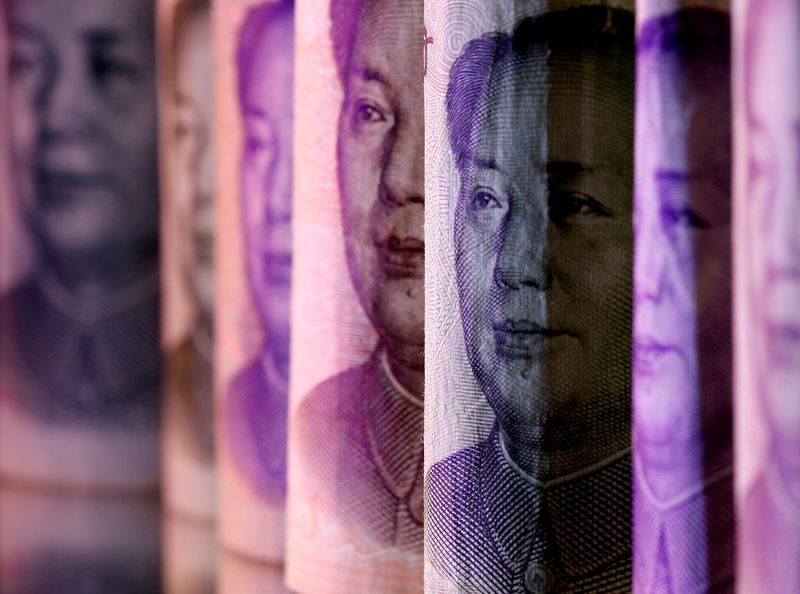By Shashwat Awasthi
(Reuters) - Bullish bets on the Chinese yuan hit a near six-month high after a rally against the U.S. dollar, a Reuters poll showed on Thursday, while investors were long on most Asian currencies as nations ramped up their COVID-19 vaccination plans.
After turning bearish on several units last month, market participants were now long on Singapore dollar, the Taiwanese dollar and the South Korean won, according to a fortnightly poll of 12 respondents.
There was no respite for Malaysia's ringgit, however, as bearish views edged up, with the nation in the midst of a two-week lockdown that could weigh on its 2021 economic growth forecast.
Malaysia is seeing a surge in coronavirus infections, with the recent number of new daily cases higher than that of India on a per capita basis.
The yuan hit a three-year high against the dollar in May and enjoyed its best month in nine, prompting China's central bank to raise the FX reserve requirement ratio (FRR) for banks and warn against speculative bets on the currency.
Analysts at Mizuho bank said in a note that moderating the build-up of, and demand for, foreign currency deposits will act as a stabilizer for the yuan.
"The tighter FRR acts as a counter-cyclical stablizer for CNY, dampening appreciation pressures as well as pre-empting vulnerability to sudden outflows," they said.
Long bets on currencies of South Korea and Singapore were at their highest since Jan. 28 and May 6, respectively, as the countries race to inoculate their citizens against COVID-19.
The Indian rupee, Asia's best performing currency in May, saw bullish positions firm to their highest since Feb 25.
"Broadly, we expect the USD/INR uptrend to be maintained this year," said Radhika Rao, an economist at Singapore bank DBS.
Investors also remained short on the Thai baht. Thailand has seen the death toll from the virus rise ten-fold over two months.
The Asian currency positioning poll is focused on what analysts and fund managers believe are the current market positions in nine Asian emerging market currencies: the Chinese yuan, South Korean won, Singapore dollar, Indonesian rupiah, Taiwan dollar, Indian rupee, Philippine peso, Malaysian ringgit and the Thai baht.
The poll uses estimates of net long or short positions on a scale of minus 3 to plus 3. A score of plus 3 indicates the market is significantly long U.S. dollars.
The figures include positions held through non-deliverable forwards (NDFs).
The survey findings are provided below (positions in U.S. dollar versus each currency):
Date CNY KRW {{2034|SGD IDIDR TWD INR MYR PHP THB
03-June -1.34 -0.51 -0.55 -0.40 -0.44 -0.71 0.32 -0.66 0.37
20-May -0.33 0.43 0.37 -0.06 0.33 -0.03 0.26 -0.22 0.81
06-May -0.52 -0.39 -0.58 0.31 -0.59 0.86 -0.04 -0.35 0.50
22-April -0.17 -0.23 -0.44 0.56 -0.38 0.75 -0.03 -0.37 0.58
08-April 0.72 0.48 0.30 0.59 0.77 0.20 0.46 0.36 0.91
25-March 0.30 0.65 0.46 0.45 0.50 0.05 0.54 0.11 0.54
11-March -0.06 0.55 0.55 0.22 -0.10 -0.37 0.50 0.09 0.49
25-Feb -1.03 -0.32 -0.57 -0.51 -0.58 -0.96 -0.13 0.01 -0.37
11-Feb -0.91 -0.24 -0.29 -0.36 -0.63 -0.53 -0.04 -0.47 -0.41

28-Jan -1.08 -0.64 -0.79 -0.41 -0.68 -0.55 -0.3 -0.66 -0.36
14-Jan -1.21 -0.87 -0.83 -0.57 -0.89 -0.22 -0.3 -0.8 -0.5